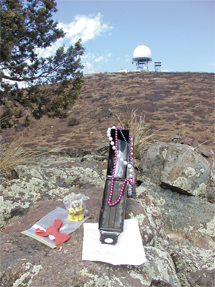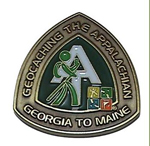Worldwide geocaching fad catching on
By Curtis Riggs | September 3, 2008
A dozen sites in Cave Creek
 CAVE CREEK – The community came into being when fortune seekers and adventurers came in search of gold.
CAVE CREEK – The community came into being when fortune seekers and adventurers came in search of gold.
Nearly a century and a half later a new type of fortune seeker is scouring the nooks and crannies of the Desert Foothills. With a dozen or more sites in the area, the geocaching craze has definitely caught on in Cave Creek.
The typical geocacher ranges from scientists and amateur geologists like Cave Creek Town Councilman Tom McGuire to young ones who do better at finding the buried geocache treasures because they are closer to the ground. McGuire touts geocaching as a family activity because young and old alike can get involved in the growing sport.
All that is needed to take up geocaching is a hand-held GPS unit, an adventurous spirit and enough time to go looking for buried treasures. Geocache sites range in size from film canisters to ammo boxes or larger. One never knows what they will find at a site. Some of the most unusual ones in Cave Creek are located near the Cave Creek town core, one which contains a photo of Cave Creek Old West historian Bob Boze Bell and the “Awe Nuts” site near Cave Creek Road and Desert Willow Parkway. McGuire is particularly proud of his “Hanging Judge of Cave Creek” site located near Cave Creek Town Hall. This is a two-part geocache, which provides a clue to where another geocache is located.
To begin geocaching one needs to register on the national website, www.geocache.com., to hide or find a site. A person then lists the longitude and latitude where they want to search or hide a site. The hand-held GPS unit is required to know the exact coordinates of one’s search.
Once one is at the correct latitude and longitude the real search for the site begins. Some geocahers are quite creative in where they place a site.
There are a couple of geocache sites at the Spur Cross Ranch Conservation Area. Area Supervisor John Gunn said the sites have caused no problems because they are both located close to trails so no one has to go and dig for them. Both he and McGuire caution people not to hide or search for geocache sites in archeological ruins because of the potential for damage to an ancient archeological site.
“They need to be placed in a way so that when people search for them they don’t disturb the ecology,” McGuire said.
 A twist to geocaching is hiding travel bugs, which experienced geocachers know should be taken to another site and re-hidden. McGuire planted a Cave Creek town pin in a site near the Hudson River in New York. He was notified the site had been found in the last couple of days.
A twist to geocaching is hiding travel bugs, which experienced geocachers know should be taken to another site and re-hidden. McGuire planted a Cave Creek town pin in a site near the Hudson River in New York. He was notified the site had been found in the last couple of days.
Top photo: This geocache site near Humbolt Mountain is one of the most popular sites in the area.
Lower photo: This geocache travel bug, which has been hidden in sites since 2006, was recently found. Cave Creek Councilman Tom McGuire, re-hid the travel bug at one of his Cave Creek sites.
Courtesy photos
